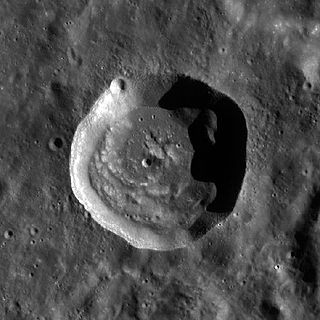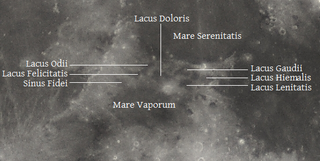
Mare Nectaris is a small lunar mare or sea located south of Mare Tranquillitatis southwest of Mare Fecunditatis, on the near side of the Moon. Montes Pyrenaeus borders the mare to the east and Sinus Asperitatis fuses to its northwestern edge. It is 84,000 square kilometers in size.

Mare Serenitatis is a lunar mare located to the east of Mare Imbrium on the Moon. Its diameter is 674 km (419 mi).

Mare Vaporum is a lunar mare located between the southwest rim of Mare Serenitatis and the southeast rim of Mare Imbrium. It was named by Giovanni Battista Riccioli in 1651.

Montes Haemus is a mountain range that forms the southwestern edge of the Mare Serenitatis basin on the Moon. They form a less prominent mirror image of the Montes Apenninus range to the west, and curve up to nearly join at the northern end. The eastern edge terminates with the Promontorium Archerusia, to the northwest of the crater Plinius. This end reaches a gap where the Mare Serenitatis to the north joins the Mare Tranquillitatis to the south.

Montes Riphaeus is an irregular range of lunar mountains that lie along the west-northwestern edge of Mare Cognitum, on the southeastern edge of Oceanus Procellarum. The range trends generally from north-northeast to south-southwest. It includes a number of slender ridge lines with valleys flooded by intruding flows of lava.

Ångström is a small lunar impact crater located on the border between Oceanus Procellarum to the west and Mare Imbrium to the east. To the south is a formation of mountains rising out of the mare named the Montes Harbinger. To the east are some wrinkle ridges named the Dorsum Bucher and Dorsa Argand. This crater is bowl-shaped, with a circular rim and inner walls that slope down to the small central floor. It has a higher albedo than the surrounding maria. The crater halo is radar dark, indicating a lack of larger blocks among the fine ejecta.

Aratus is a small lunar impact crater located on the highland to the south and east of the rugged Montes Apenninus range. It is a circular, cup-shaped crater with a relatively high albedo. It was named after Greek astronomer Aratus of Soli. To the east is the Mare Serenitatis, and to the southwest is the somewhat larger crater Conon. North-northeast of Aratus is the landing site of the Apollo 15 mission, just beyond Mons Hadley Delta.

Calippus is a small lunar impact crater that is located on the eastern edge of the rugged Montes Caucasus mountain range in the northern part of the Moon. It was named after Greek astronomer Callippus of Cyzicus. It lies to the southwest of the crater remnant Alexander, to the northwest of the Mare Serenitatis.

Montes Alpes is a mountain range in the northern part of the Moon's near side. It was named after the Alps in Europe; the name was confirmed by the International Astronomical Union in 1935. It lies between the selenographic coordinates latitudes 52.81°N and 42.04°N, and longitudes 5.6°W and 3.22°E. The range thus crosses the lunar prime meridian, and is partially illuminated and partially in shadow during first and last quarters. The center of the range is at 48.36°N, 0.58°W, and has a diameter of 334 km.

Daubrée is a lunar impact crater that is located to the southwest of the Mare Serenitatis, just to the west-southwest of the crater Menelaus in the Montes Haemus range. The small lunar mare Lacus Hiemalis lies along the southwest rim of Daubrée. The crater was named after French geologist Gabriel A. Daubrée. It was previously designated Menelaus S.

Chant is a lunar impact crater that is located on the far side of the Moon, behind the southwest limb as seen from the Earth. It lies within the southwestern part of the blanket of ejecta surrounding the Mare Orientale, beyond the Montes Cordillera mountain ring. To the west-northwest is the large walled plain Blackett. Southward is the crater Mendel.

Montes Cordillera is a mountain range on the Moon. This feature forms the outer wall of peaks that surround the Mare Orientale impact basin, the inner ring being formed by the Montes Rook. The center of the range is located at selenographic coordinates 17.5° S, 81.6° W, and the diameter is 574 km (357 mi).

Mons Piton is an isolated lunar mountain that is located in the eastern part of the Mare Imbrium, to the north-northwest of the crater Aristillus. Due east of Mons Piton is the flooded crater Cassini, and to the west-northwest lies Piazzi Smyth. North and northeast of this massif is the Montes Alpes range, forming the northeast edge of the lunar mare.

Eichstadt is a lunar impact crater that is located in the eastern section of the Montes Cordillera range that encircles the Mare Orientale impact basin. It lies toward the southwestern limb of the Moon, and so appears oblong when viewed from the Earth due to foreshortening. Over 200 kilometers to the east of Eichstadt are the craters Darwin and Lamarck, and to the south is Krasnov.

Mons Vinogradov is a rugged massif that is located on the lunar mare where Oceanus Procellarum to the southwest joins Mare Imbrium to the east. There are three primary peaks in this formation, which rise to altitudes of 1.0–1.4 km above the surface. To the east of this rise is the crater Euler, and to the southeast is an area of rugged ground that reaches the Montes Carpatus range. The Carpatus mountain range forms the southwest boundary of the Mare Imbrium.

Montes Secchi is a minor range of lunar mountains located near the northwestern edge of Mare Fecunditatis. This roughly linear formation of low ridges grazes the northwestern outer rim of the crater Secchi, the formation from which this range gained its name. This crater is named after Angelo Secchi, a 19th-century Italian astronomer. The ridges trend from southwest to northeast.

Palus Putredinis is a small lunar mare in the basin of Mare Imbrium. It stretches from the crater Archimedes southeast toward the rugged Montes Apenninus range located on the southeastern edge of Mare Imbrium. This region is a nearly level, lava-flooded plain bounded by the crater Autolycus and nearby highlands to the northeast and the foothills of the Montes Archimedes to the southwest. The selenographic coordinates are 27.4° N, 0.0° E, and it lies within a diameter of 180 kilometers (110 mi).

Terra Nivium is a roughly triangular highland region on the Moon. In his Almagestum novum, the notable selenographer Giovanni Riccioli named the various highland regions terrae. However, unlike his naming scheme for craters and lunar maria, his nomenclature for the continental areas of the Moon never came into common use.

Montes Caucasus is a rugged range of mountains in the northeastern part of the Moon. It begins at a gap of level surface that joins the Mare Imbrium to the west with the Mare Serenitatis to the east, and extends in an irregular band to the north-northeast to the western side of the prominent crater Eudoxus. The range forms the northwestern boundary of the Mare Serenitatis. It forms a continuation of the Montes Apenninus range to the southwest.

Hadley–Apennine is a region on the near side of Earth's Moon that served as the landing site for the American Apollo 15 mission, the fourth crewed landing on the Moon and the first of the "J-missions", in July 1971. The site is located on the eastern edge of Mare Imbrium on a lava plain known as Palus Putredinis. Hadley–Apennine is bordered by the Montes Apenninus, a mountain range, and Hadley Rille, a meandering channel, on the east and west, respectively.























